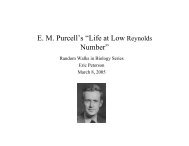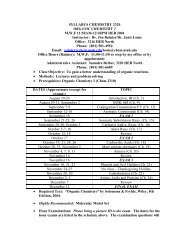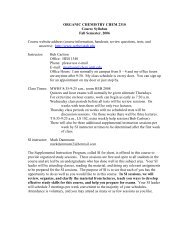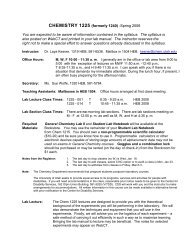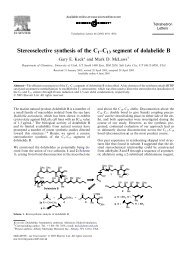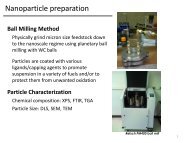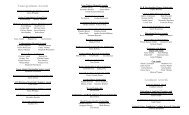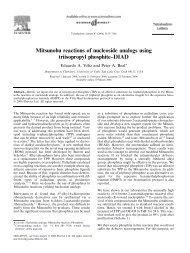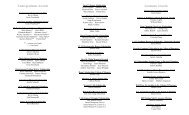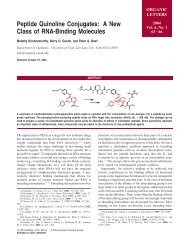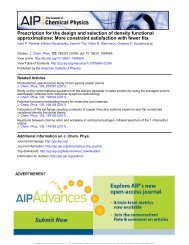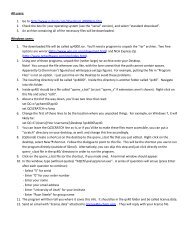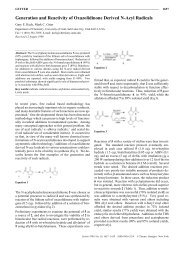CHEMISTRY 2315 COURSE SYLLABUS - Department of Chemistry ...
CHEMISTRY 2315 COURSE SYLLABUS - Department of Chemistry ...
CHEMISTRY 2315 COURSE SYLLABUS - Department of Chemistry ...
Create successful ePaper yourself
Turn your PDF publications into a flip-book with our unique Google optimized e-Paper software.
<strong>CHEMISTRY</strong> <strong>2315</strong> <strong>COURSE</strong> <strong>SYLLABUS</strong><br />
<strong>COURSE</strong><br />
DESCRIPTION:<br />
PREREQUISITES:<br />
INSTRUCTOR:<br />
<strong>Chemistry</strong> <strong>2315</strong> will introduce all the fundamental organic chemistry laboratory<br />
techniques. Emphasis will be on performance and understanding <strong>of</strong> the theory<br />
behind the experimental techniques.<br />
Chem 2310 is a co-requisite (or prerequisite) for Chem <strong>2315</strong> and Chem <strong>2315</strong> is a<br />
prerequisite for 2325. Chem <strong>2315</strong> and 2325 cannot be taken simultaneously.<br />
Bub Carlson<br />
Office hours: I am normally on campus from 8 – 4 and you are welcome anytime<br />
after 9:30. My class schedule is on my door. You can sign up for<br />
an appointment on my door or just stop by. TA’s also have weekly <strong>of</strong>fice<br />
hours; see bulletin board and course website for details <strong>of</strong> TA hours.<br />
Room: 1340 HEB<br />
Phone: please use e-mail<br />
Email: mcarlson@chem.utah.edu<br />
LECTURES: Sect 001, H 10:45-11:35, HEB 2008 (students can attend either lecture<br />
Sect 012, H 3:40-4:30, HEB 2004 section regardless <strong>of</strong> lab section)<br />
LAB: Sect 002, F 1 - 5, HEB 4111 Sect 013, T 5 – 9, HEB 4111<br />
Sect 003, M 1 - 5, HEB 4103 Sect 014, H 5 – 9, HEB 4103<br />
Sect 004 , H 1 - 5, HEB 4111 Sect 015, M 1 – 5, HEB 4111<br />
Sect 005, W 1 - 5, HEB 4103 Sect 016, W 1 – 5, HEB 4111<br />
Sect 006, H 1 - 5, HEB 4103 Sect 017, T 1 – 5, HEB 4103<br />
Sect 007, F 1 - 5, HEB 4103 Sect 018, H 5 – 9, HEB 4111<br />
Sect 008, M 5:30–9:30, HEB 4103 Sect 019, M 5:30–9:30, HEB 4111<br />
Sect 009, T 5 – 9, HEB 4103 Sect 020, W 5:30-9:30, HEB 4103<br />
Sect 010, W 5:30–9:30, HEB 4111<br />
Sect 011, T 1 – 5, HEB 4111<br />
TEXTS:<br />
Organic <strong>Chemistry</strong>, Experiments and Techniques<br />
Authors: W.W. Epstein; Jimmy Lee Seidel; Craig S. Young<br />
Published by Hayden-McNeil, ISBN 0-7380-1697-7 (second edition)<br />
Customized Lab Record, or similar bound notebook with carbon copies<br />
Published by Hayden-McNeil, ISBN 1571829792<br />
Lectures for <strong>Chemistry</strong> <strong>2315</strong> (copies <strong>of</strong> lecture transparencies),<br />
Bub Carlson (optional, also on course website)<br />
TEACHING<br />
ASSISTANTS:<br />
STOCKROOM<br />
ATTENDANTS:<br />
The laboratory teaching assistants have full responsibility and authority in the<br />
laboratory. Please respect their authority by being responsible individuals when<br />
a request is made.<br />
Get your TA’s e-mail address so that you can communicate with him/her in case<br />
you miss a lab or an assignment. The TA’s mailboxes are located in HEB<br />
1504. Be sure to put your TA’s name on anything you put in the mailbox because<br />
all TAs share mailboxes.<br />
The stockroom personnel have full responsibility and authority over laboratory<br />
and stockroom policies and procedures. Please respect their authority by being<br />
responsible individuals when a request is made.
RESPONSIBILITY:<br />
ATTENDANCE:<br />
MAKE-UP LABS:<br />
You are responsible for all information and announcements given in class. If you<br />
miss a lecture or are late for a lecture be sure to get the information from another<br />
student. Please do not call and ask questions about this information.<br />
Attendance is required. You learn by doing, not by the vicarious work <strong>of</strong> your<br />
friends. Because <strong>of</strong> limited availability <strong>of</strong> special equipment all students are<br />
encouraged to work in pairs on all experiments. It is recommended you switch<br />
lab partners frequently. Any student wishing to work alone may do so.<br />
Make-up labs are permitted in certain circumstances. If you cannot attend your<br />
regular laboratory section for a legitimate reason, it is your responsibility to<br />
inform your pr<strong>of</strong>essor to discuss the situation and get a signed permission form<br />
to do the make-up lab. You must pick up the form in HEB 1340; do not send an<br />
e-mail to inform your pr<strong>of</strong>essor you must miss a lab, just get the make-up<br />
permission form. Give the permission form to the TA <strong>of</strong> the lab where the makeup<br />
work is to be done, and that TA will certify the work has been done and notify<br />
your regular TA. The make-up experiment should preferably be done that same<br />
week, or at the very latest the following week. No make-up labs can be done later<br />
than one week after the normally scheduled time.<br />
POINT<br />
BREAKDOWN: 1) Prelab 8 x 10 80<br />
2) Lab work/notebook 8 x 40 320<br />
3) Conclusions 8 x 50 400<br />
4) Quizzes 8 x 20 160<br />
TOTAL POINTS POSSIBLE 960<br />
GRADING:<br />
You are expected to complete eight labs. If you do not complete at least six labs<br />
you will automatically fail the course. Nine labs are scheduled, so if you miss one<br />
<strong>of</strong> the labs without making it up during the semester you can do the final makeup<br />
lab to substitute for the missed experiment if you have not already made it up.<br />
If you have done the first eight labs you can still choose to do the make-up lab to<br />
replace the grade <strong>of</strong> an earlier experiment.<br />
Everyone who conscientiously does all eight labs with complete write-ups, and<br />
eight quizzes (earning a minimum <strong>of</strong> 50% <strong>of</strong> total possible quiz points) will<br />
receive an A or a B. Missing two or more labs will result in a fail. A missing<br />
write-up will be considered equivalent to missing half a lab. Five missing quizzes<br />
will be considered equivalent to missing one lab. Persons who fail to do all<br />
required work, but complete more than seven labs will receive a C or a D.<br />
Persons who do not take all quizzes, do not have a minimum <strong>of</strong> 50% <strong>of</strong> total<br />
possible quiz points, do not write full and conscientious conclusions, and do not<br />
turn in conclusions on time will not be guaranteed a minimum grade <strong>of</strong> B-.<br />
For those who complete all the required work, you will be graded on a curve <strong>of</strong><br />
A’s and B’s. TA’s may vary slightly in their grading on quizzes and write-ups, so<br />
you will be graded only in comparison to other students in your TA’s sections, not<br />
in any other TA’s section.<br />
Your TA’s will be told to show you your point total (and how you are doing<br />
relative to the rest <strong>of</strong> your section) about half way through the semester and at<br />
check-out time.<br />
QUIZZES:<br />
Quizzes will be given at the end <strong>of</strong> each lecture covering the experiment done the<br />
previous week. Be sure to put your completed quiz in the correct folder for your<br />
section or your TA may not receive your quiz. One <strong>of</strong> the main purposes <strong>of</strong> the<br />
quizzes is to encourage you attend lectures. Under no circumstances may quizzes<br />
may be taken early or late! Do not even ask! There will be one make-up quiz<br />
given during the last class period over the make-up lab that can be used to<br />
replace a missing quiz or to replace the score <strong>of</strong> a lower quiz. You do not have to
do the make up lab to take the make up quiz.<br />
For the best performance on quizzes it is recommended you always do your lab<br />
write-up (or at least a draft <strong>of</strong> your write-up) before the quiz. Quizzes will<br />
emphasize lecture material.<br />
Your quizzes and your write-ups should be returned to you by your TA by the<br />
following week so that you can learn from your mistakes. Keys to quizzes will be<br />
posted on the bulletin board outside <strong>of</strong> the labs. If your work is not returned by<br />
your TA within two weeks, notify your pr<strong>of</strong>essor.<br />
CHECK-IN:<br />
Check-in will occur in the first laboratory period. You are required to bring a<br />
combination (not key) lock, goggles, and paper towels. Your lock combination<br />
number will be left with the attendant for emergencies. Failing to bring a lock<br />
after the second lab will automatically prevent you from doing any further lab<br />
work.<br />
Many students register for the course and later decide to drop. Lab space is in<br />
high demand. Students who do not attend the first day <strong>of</strong> lab for check-in, or<br />
who are not on time will be assumed to be dropping the course and their lab<br />
benches will be given to someone else. Students who must miss the first lab for a<br />
reasonable excuse can reserve their lab bench by notifying your pr<strong>of</strong>essor in<br />
advance.<br />
If you switch sections, do NOT change your registration with the registrar. You<br />
instructor will change the section you are registered for. Changing sections with<br />
the registrar would require getting a permission code.<br />
As part <strong>of</strong> the check-in you must be sure to sign the locker assignment sheet in<br />
the lab (with the correct number for the lab bench you have selected). If you do<br />
not sign the locker assignment sheet, then you are not registered for your lab<br />
bench and it may be given to other students registering late.<br />
EQUIPMENT:<br />
You are accountable for the equipment in your organic chemistry locker. On the<br />
first day <strong>of</strong> lab, your teaching assistant will assign a locker to you. Make sure to<br />
put a combination lock on the locker as you may be penalized for the replacement<br />
<strong>of</strong> missing items later during the quarter.<br />
Located inside your equipment locker is a breakage card listing the entire<br />
contents <strong>of</strong> your locker. At check in, verify all items against the list. If anything is<br />
missing, the stockroom attendant will replace the item. During the semester,<br />
when you lose or break an item, the stockroom attendant will punch the card next<br />
to the item name to indicate that they have replaced the item. At the end <strong>of</strong> the<br />
semester, you may be assessed a grade point penalty based upon any breakage or<br />
loss in excess <strong>of</strong> that amount covered by your special course fee. Be careful with<br />
your equipment and do not lose the breakage card.<br />
BREAKAGE:<br />
Your laboratory fee is used primarily to cover the cost <strong>of</strong> chemicals and materials<br />
you use during the semester. It also includes a small component for small items<br />
in your drawer that are occasionally broken or lost. It does not cover breakage <strong>of</strong><br />
special, major equipment that is not part <strong>of</strong> your equipment locker.<br />
When doing the experiments part <strong>of</strong> your assignment is to work carefully without<br />
breaking equipment, particularly special equipment. If you do break a major<br />
piece <strong>of</strong> equipment during an experiment, you will lose all the points for that<br />
experiment (100 points). In most cases the loss <strong>of</strong> 100 points will cost you one or<br />
two grades (i.e., it would lower a grade <strong>of</strong> A to an A- or a B+). If you were to lose<br />
100 points on three experiments, you would fail to complete the minimum<br />
number <strong>of</strong> required experiments (6) and you would fail the course.
As an alternative to losing 100 points, you may replace the equipment. You may<br />
obtain the equipment on your own, or the organic stockroom will replace it for<br />
you (at their wholesale cost). You can write a check, payable to the University <strong>of</strong><br />
Utah <strong>Department</strong> <strong>of</strong> <strong>Chemistry</strong>, and make your payment at the organic<br />
stockroom. If you do not replace the equipment or write a check to replace the<br />
equipment by the end <strong>of</strong> the last week <strong>of</strong> the semester, you will automatically lose<br />
100 points for the experiment in which the equipment was broken.<br />
The costs for breakage <strong>of</strong> major equipment such as a 125 mL separatory funnel, a<br />
condenser, a 500 mL 3-neck rb flask, and a chromatography column are<br />
approximately $65. Be careful when using this special equipment!<br />
CHECK-OUT: Check-out will occur at the end <strong>of</strong> the last lab and generally takes about 15<br />
minutes. You are required to clean all your glassware and review the glassware<br />
with your TA. Failure to check out will result in your grade being lowered one<br />
level (e.g., an A- to a B+).<br />
NOTEBOOK:<br />
The purpose <strong>of</strong> a laboratory notebook is to record all pertinent information about<br />
a laboratory procedure while the procedure is being done; this promotes the<br />
accurate communication <strong>of</strong> the procedure to the scientific community and/or any<br />
other interested party.<br />
You are required to purchase the “Customized Lab Record” from the bookstore.<br />
This is a carbonless, duplicate set laboratory notebook that will allow you to give<br />
one copy <strong>of</strong> your notebook entry to the teaching assistant. You are required to<br />
get the signature <strong>of</strong> your TA on the bottom <strong>of</strong> the last page before leaving the lab<br />
for the day. You must follow the format presented below for your notebook entry.<br />
It is recommended you use the left side <strong>of</strong> the page for outlining procedures and<br />
the right side for observations. Read section 1.2 in your Techniques manual (the<br />
second half <strong>of</strong> the lab manual) for more information, including guidance in<br />
common calculations. You will submit notebook entries together with the<br />
discussion written at home a week after performing the experiment.
SAMPLE NOTEBOOK ENTRY:<br />
A. Experiment #6: The Synthesis <strong>of</strong> Stilbene Using a Phase-Transfer Wittig Reaction<br />
B. Main Reaction:<br />
C 6 H 5 CHO + (EtO) 2 POCH 2 C 6 H 5<br />
Aliquat 336 / 40% KOH<br />
C6 H 5 CH=CHC 6 H 5<br />
hexanes, heat<br />
C. Physical Data (from: CRC Handbook 52 nd Edition; Aldrich Catalog, 1988-1989):<br />
PhCHO (EtO) 2 -POCH 2 Ph Aliquat 336 PhCH=CHPh<br />
molecular wt. 106.12 196.1 501.5 180.25<br />
density 1.044 1.095 0.884<br />
b.p. (°C) 178.1 106.108 1torr 305 720torr<br />
m.p. (°C) 124.5-124.8<br />
ml used 0.25 0.55 0.25<br />
wt. used (g) 0.26 0.60 0.22<br />
mmol used 2.45 (limiting) 3.05 (excess) 0.44 (catalyst)<br />
D. Brief Procedure Outline:<br />
Assemble a reflux apparatus with a 10 mL rb flask.<br />
Add 0.25 mL Aliquat 336, 0.25 mL benzaldehyde,<br />
0.55 mL diethylbenzylphosphonate, 2 mL<br />
hexanes, 2 mL 40% KOH.<br />
Reflux 1.5 hr.<br />
Cool 10 min, place in ice bath 10 min.<br />
Remove the lower layer.<br />
Collect crystals by suction filtration.<br />
Wash crystals; cold water x 2, cold ethanol x 2.<br />
Recrystallize from 3 mL ethanol and collect crystals.<br />
Take mp and determine yield.<br />
E. Actual Procedure & Observations: (Brief procedure does not need to be repeated, just write actual<br />
procedure and observations on right side <strong>of</strong> page.)<br />
Assemble a reflux apparatus with a 10 mL rb flask. Empty thermowell <strong>of</strong> sand, start magnetic stirrer,<br />
refill thermowell with sand.<br />
Add 0.25 mL Aliquat 336, 0.25 mL benzaldehyde, Add hexanes first—Aliquat 336 very viscous.<br />
0.55 mL diethylbenzylphosphonate, 2 mL Clean pipet (acetone, air) after each reagent.<br />
hexanes, 2 mL 40% KOH.<br />
Wrap pipet with Parafilm so bulb fits.<br />
Reflux 1.5 hr.<br />
During reflux colorless reaction mixture turned<br />
A bright pink color.<br />
Cool 10 min, place in ice bath 10 min.<br />
Cooling stops reaction. Crystals form.<br />
Remove the lower layer.<br />
Use Pasteur pipet to remove lower (aq) layer.<br />
Collect crystals by suction filtration.<br />
Use Hirsch funnel.<br />
Wash crystals; cold water x 2, cold EtOH x 2. Use 1 mL each cold water, cold EtOH.<br />
Recrystallize from 3 mL ethanol and collect crystals. Needed about 4 mL hot EtOH to completely<br />
dissolve solid. Cool in ice bath. Crystals were<br />
white platelets.<br />
Take mp and determine yield. Dry in oven for 10 min at 100 o C.<br />
Mp was 124.4-126.6 o C. Yield was 0.21 g.<br />
Actual: 0.21 g / 180.25 g mol -1 = 1.17 mmol x 100 = 45 % yield<br />
Theoretical: 0.25 mL x 1.095 g mL -1 / 106.12 g mol -1 2.58 mmol
NOTEBOOK:<br />
1. Leave the first two pages <strong>of</strong> your notebook blank and make a table <strong>of</strong> contents.<br />
2. Items A – D constitute the prelab. The pre-lab should be done before you<br />
come to the lab and will be graded by the T.A. Item E is to be done during the<br />
lab and F is to be done at home following the lab.) See sample notebook entry<br />
after this section.<br />
A. Title.<br />
B. Equations (for labs 6 - 8) or molecular structures.<br />
C. Physical data for all reactants used and products produced<br />
and solvents (with literature reference cited) with appropriate<br />
precautions (when using dangerous chemicals such as sulfuric acid).<br />
There are no physical constants for lab 1.<br />
D. Brief procedure outline. Summarize the procedure, writing a<br />
sequence <strong>of</strong> well-defined steps that you are going to perform. Make<br />
sure that each step is described briefly so that you can easily read and<br />
follow it during the lab work. Avoid copying the text <strong>of</strong> the manual<br />
word for word. Write this outline on the left side <strong>of</strong> your notebook<br />
page.<br />
E. Actual procedure and observations (data sheets). Include<br />
comments about what occurs during the experiment, like color<br />
changes, gas evolution, precipitates, etc. Make sure to write in such a<br />
manner that a person who would like to reproduce the experiment<br />
that you did can do so without getting verbal instructions from you<br />
and can then get identical results to yours. Be sure to write during<br />
the lab as you perform the experiment. Also include things that<br />
occurred that were not planned and which may or may not influence<br />
your results. Note that authentic description <strong>of</strong> the actual procedure<br />
sometimes demands recording the time. Write these observations on<br />
the right side <strong>of</strong> your notebook page.<br />
F. Discussion and Conclusion. Explain your results and<br />
observations as well as any unexplained aspects <strong>of</strong> your experiment.<br />
Indicate if the goals were achieved. If they were not, do an error<br />
analysis.<br />
3. At the end <strong>of</strong> lab, you will tear out the carbon copy <strong>of</strong> your completed, signed<br />
notebook entry and hand it in to your T.A. before leaving.<br />
The notebook entry is not to be a regurgitation <strong>of</strong> printed material, but a brief<br />
account <strong>of</strong> what you really did. In your conclusion, tie together the purpose with<br />
the results and <strong>of</strong>fer explanations for low yield, etc.<br />
PRE-LAB:<br />
It is important that you have read the laboratory experiment in advance and are<br />
prepared to begin work. It is your responsibility to read the experimental<br />
procedure and background information until you understand the details <strong>of</strong> the<br />
experiment. To assure your advance preparation you are required to submit a<br />
prelab sheet within the first 10 minutes <strong>of</strong> the lab or else no credit will be given<br />
for the prelab. This prelab will include sections A-D <strong>of</strong> the notebook record (see<br />
below). You may start work only after your TA has signed the prelab. No work is<br />
permitted without writing a prelab.
PHYSICAL<br />
CONSTANTS:<br />
LAB WORK:<br />
CONCLUSIONS:<br />
Physical constants can be found in appendix 1 and 2 <strong>of</strong> your lab manual. They are<br />
also available at chemfinder.com on the web and in hard copies <strong>of</strong> the Merck<br />
Index and the Chemical Rubber Company Handbook <strong>of</strong> <strong>Chemistry</strong> and Physics<br />
in the Science Reserve desk on the fourth floor <strong>of</strong> the Marriott Library. To find<br />
the electronic edition <strong>of</strong> the CRC go to http://www.lib.utah.edu research tools<br />
article databases C (or same route for the electronic edition <strong>of</strong> the Merck).<br />
Record your observations on the right side <strong>of</strong> your notebook opposite the<br />
procedure you recorded for the pre-lab. Your lab work will be worth 40 points.<br />
Poor quality lab work and low yields cause a reduction <strong>of</strong> points awarded,<br />
especially for students who repeatedly achieve poor results.<br />
Your conclusions, including answers to any questions or topics your TA assigns<br />
will be collected at the beginning <strong>of</strong> the next scheduled lab period. Conclusions 1<br />
- 7 days overdue will be lowered 7 points for each day they are late.<br />
Conclusions more than 7 days overdue will not be accepted.<br />
Conclusions for the make-up lab are due in your TA’s mailbox (HEB 1504) one<br />
week after you complete the make-up lab.<br />
Conclusions must be written individually, even if the experiment is done with a<br />
lab partner.<br />
The conclusions/final write-ups for the experiments should be sufficiently<br />
concise so as to not exceed two pages, and it is doubtful you can do an adequate<br />
job in much less than two pages. They should be done on computer, doublespaced.<br />
A sample write-up is found on the web page.<br />
The content <strong>of</strong> the conclusion will vary a lot depending on the type <strong>of</strong> experiment<br />
done. During the first part <strong>of</strong> the semester the primary emphasis will be on<br />
introduction <strong>of</strong> techniques and equipment, while during the last two weeks <strong>of</strong> the<br />
semester you will be conducting chemical reactions. In either case your<br />
conclusion should not include procedure. It should concentrate on “why”<br />
and not “what”. Your conclusion should be scientific and objective, and should<br />
not include any personal pronouns. Be sure to organize your conclusion.<br />
If the experiment introduces new techniques and equipment, such as TLC or<br />
fractional distillation, you should first discuss your experimental results and then<br />
the techniques. In TLC, for example, explain the logic behind how you decided<br />
the contents <strong>of</strong> your analgesics and determined your unknown, or explain how<br />
effective fractional distillation was in separating your two liquids. You need to<br />
provide or summarize important results (include TLC plates, distillation tables,<br />
etc). You also need to explain the important concepts behind the technique and<br />
equipment you were using; what is its purpose and what is the theory behind its<br />
operation. Explain why TLC or fractional distillation was able to separate<br />
compounds effectively.<br />
If the experiment involves a chemical reaction, you should begin by restating the<br />
chemical reaction and give its mechanism. The mechanism should never exceed<br />
½ page. Explain why you did certain important things in the reaction procedure<br />
(why was a catalyst or a reflux necessary, why was it necessary to have anhydrous<br />
conditions, why was an extraction or recrystallization or cooling necessary, etc).<br />
What did some <strong>of</strong> your observations indicate about the reactions that were<br />
occurring? How were impurities, by-products, and unreacted starting materials<br />
removed during the work-up?
Give your percent yield and show how you did your calculation (indicating<br />
limiting reagent). Compare your melting point range with the literature value<br />
(and include a reference). Discuss the quantity and purity <strong>of</strong> your product, and<br />
do an error analysis on your results if you had problems. Explain the possible<br />
sources <strong>of</strong> a low yield or impurities and what you would do differently if you were<br />
to repeat the experiment.<br />
You should emphasize concepts in your write-up that were emphasized in the lab<br />
lecture. Your TA may also give you an indication <strong>of</strong> important concepts that you<br />
should include in your write-up.<br />
If you use a reference for your conclusion, be sure to indicate it. Plagiarism in the<br />
conclusion is unethical and will result in a failure on the entire write-up.<br />
For best results on quizzes it is recommended you always do your write-up (or at<br />
least a draft <strong>of</strong> your write-up) before the quiz. Flow sheets (experiments 7 on)<br />
will be particularly helpful in your write-ups.<br />
If you have difficulty writing coherent conclusions, you can go to the University<br />
Writing Center for help. They are located on the third floor <strong>of</strong> the Marriott<br />
Library. Their phone number is 587-9122 and their website is<br />
www.writingcenter.utah.edu/. If your conclusions are poorly written your TA<br />
will not accept them.<br />
DISABILITIES:<br />
Any student needing special consideration because <strong>of</strong> a disability should contact<br />
the Center for Disability Services, 162 Union. It is recommended that any<br />
student who is pregnant delay taking organic laboratory courses until the<br />
pregnancy is complete.<br />
The University <strong>of</strong> Utah seeks to provide equal access to its programs, services and<br />
activities for people with disabilities. If you will need accommodations in the<br />
class, reasonable prior notice needs to be given to the Center for Disability<br />
Services, 162 Olpin Union Building, 581-5020 (V/TDD). CDS will work with you<br />
and the instructor to make arrangements for accommodations.<br />
All written information in this course can be made available in alternative<br />
format with prior notification to the Center for Disability Services.
LAB SCHEDULE FOR <strong>CHEMISTRY</strong> <strong>2315</strong><br />
Chem <strong>2315</strong> Online: webCT.utah.edu<br />
Organic <strong>Chemistry</strong> Laboratory<br />
Fall, 2006<br />
Week Beginning Lecture Topics (H) Laboratory (M-F)<br />
August 8/23 Introduction No Lab<br />
8/28 No Lecture Check-In<br />
September 9/4<br />
Lab #1<br />
No Lab<br />
(Labor Day)<br />
9/11 Lab #2 Lab #1 – Thin Layer<br />
Chromatography<br />
9/18 Lab #3<br />
Quiz over Lab #1<br />
Lab #2 – Fractional<br />
Distillation<br />
9/25 Lab #4<br />
Quiz over Lab #2<br />
October 10/2 No lecture<br />
(Fall Break)<br />
10/9 Lab #5<br />
Quiz over Lab #3<br />
10/16 Lab #6<br />
Quiz over Lab #4<br />
10/23 Lab #7<br />
Quiz over Lab #5<br />
Lab #3 – Column Isolation<br />
<strong>of</strong> Plant Pigments<br />
No Lab<br />
Lab #4 – Steam Distillation<br />
(bring orange)<br />
Lab #5 – Preparation <strong>of</strong> an<br />
Ether by Nucleophilic<br />
Substitution<br />
Lab #6 – Dehydration <strong>of</strong><br />
Cyclohexanol<br />
10/30 Lab #8<br />
Quiz over Lab #6<br />
Lab #7 – Borohydride<br />
Reduction<br />
November 11/6 Make-Up Lab<br />
Quiz over Lab #7<br />
Lab #8 – Diels-Alder<br />
Reaction<br />
11/13 Quiz over Lab #8<br />
Quiz over make-up lab<br />
Make-up Lab – Electrophilic<br />
Addition & Purification <strong>of</strong><br />
Cholesterol (optional),<br />
Check-Out (required)<br />
11/20 No lecture<br />
No lab<br />
(Thanksgiving)<br />
Make-up lab write up due<br />
11/27 No lecture No lab



